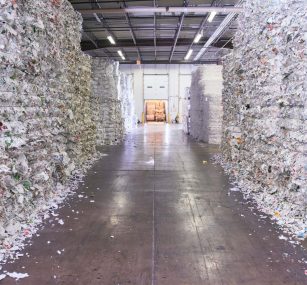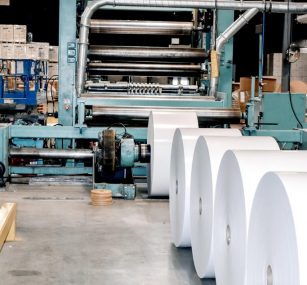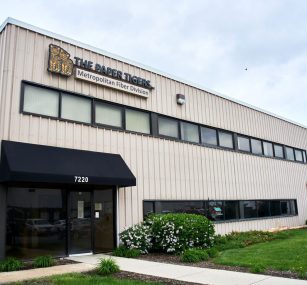FAQs
Check out the frequently asked questions to the right. If you have additional questions, please reach out to us. We’d love to help you.
What is job lot paperboard?
The terms job lot, odd lot, or stock lot are used to designate rolls or sheets that are sold in the secondary market. As such, this product has already been manufactured, and is not made to order. Also known as second quality, job lot is not guaranteed to be free from defects. However, it is typically suitable for most simple printing and packaging needs.
What is the difference between SBS and FBB?
SBS (Solid Beach Sulfate) is a single or multi-ply paperboard that contains chemical pulp. FBB (Folding Box Board) on the other hand is a multi-ply sheet that contains chemical pulp and mechanical or thermo-mechanical pulp. FBB is designed to create yield advantage over traditional, single ply boxboard.
What is your minimum order?
No job is too large or too small. Whether you need one roll/skid, or multiple truck loads, we are here to assist.
What mills do your products come from?
We purchase product from a number of North American suppliers.
What are the typical end uses for our job lot products?
Our products are generally recommended for unprinted jobs or printed jobs with up to 50% ink coverage, and up to four colors. If you need help determining what is right for your needs, please contact us and we will happily provide additional guidance
How much does recycling equipment cost?
We are here to help you with financing solutions. Tell us about your waste stream and we will find you the best equipment for the job.
In most cases, the volume of scrap material will determine the type of equipment solution necessary to adequately handle your material. Other factors such as your plant floor space design or amount of labor you are looking to save can influence what may end up being the appropriate level of investment.
Prices vary by system, but we are committed to finding you equipment at the lowest cost for your particular recycling needs.
What about financing?
At Paper Tigers, we understand that many of our clients have tight budgets with other process improvements and other operational costs higher on the list of priorities than scrap processing or recycling equipment. That’s why we will work with you to come up with a customized recycling solution and payment plan that fits your needs.
What equipment is right for my business?
There are many types of equipment that you may be interested in learning about. Here are just a few:
Horizontal Baler
A horizontal baler has high capacity and fast cycle times, so it is ideal for companies that produce larger volumes of scrap and want to process material for resale.
Advantages of the horizontal baler include:
- Automated Operation
- Labor Savings
- Superior Densification
- Favorable Presentation of Scrap Product
Vertical Baler
If your business does quite a bit of unpacking or repacking of boxes and has a problem with build-up of boxes on the floor or in your garbage dumpster, you may need a vertical baler. Installing a vertical baler will allow you to take your boxes and compact them into bales, creating space and adding value to material.
Advantages of vertical balers include:
- Small Footprint
- Reduced Disposal Cost
- Generate Revenue from a Waste Stream
How can The Paper Tigers/Metropolitan Fiber help my business more effectively manage our recycling efforts?
If your business generates any significant quantity of scrap paper or plastic from manufacturing, converting, distribution, or fulfillment, contact us to find out how we can help optimize your process and maximize the potential for revenue generation. We help our valued suppliers design processes to more efficiently sort, grade, collect, store and ship their recyclables.
What is the first step in getting started?
Typically, we like to conduct what is known as an onsite waste audit. We will visit your place of business to assess your processes that generate paper and/or plastic scrap, then make specific recommendations as to how best to segregate, collect, and densify recyclables for shipment. Based on your specific needs and desired outcomes, we will recommend equipment and processes that can be implemented to immediately turn byproduct into a new source of cash flow.
How should different grades of paper scrap be segregated or sorted for collection to maximize return?
Diligent, proper segregation of grades is the most important step you can take to maximize the value of your paper scrap and the resultant revenue stream from its sale. Some of the most important attributes for segregation are as follows:
- Bleached vs unbleached – brown paper and paperboard should always be kept separated from white paper and board. Mixing the two will result in the lowest value grade, mixed paper. Even pure unbleached paper and board fiber has a significantly higher value.
- Woodfree vs groundwood – woodfree papers such as printing and writing grades should be segregated from groundwood grades such as newsprint, lightweight coated, and supercalandred papers. Mixing chemical (woodfree) with mechanical pulp papers (groundwood) will result in the entire pack being classified as groundwood.
- Coated vs uncoated – clay coated stock should be segregated from uncoated stock to the greatest possible extent. Comingling will result in the entire pack being classified as coated.
- Printed vs unprinted – to maximize the value of your unprinted scrap, keep it out of your printed scrap.
- Colored papers such as beater-dyed colors and semi bleached fiber papers should be segregated to avoid downgrade of entire pack to mixed paper.
- Polyethylene (PE) coated paper and board should always be segregated in order to avoid contamination of non-poly coated paper and board scrap grades. This is a very specialized grade of recycled fiber that is consumed by a small handful of mills. Poly contamination can result in very costly damage to pulp and paper mill equipment.
- Recycled boxboard is generally a very low value fiber, and should be segregated to avoid downgrade of entire pack to mixed paper.
Any questions about how best to segregate or mix new or unfamiliar grades of paper? Please call your account representative at The Paper Tigers / Metropolitan Fiber.
Contact Us Today
No matter the size of your project or scope of your business we are here to help. Call us today to find out just how we can help you with your recycling or paperboard needs.



